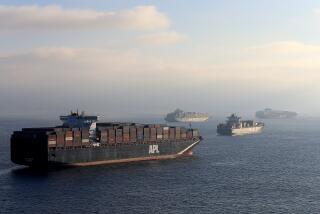Shippers Handle Overheated Cargoes Like a Hot Potato
Problems with hot coal, like that being unloaded from the Fort Providence cargo ship in Los Angeles Harbor, have been relatively uncommon since 1981, when a rash of smoldering cargoes prompted new procedures for handling them.
Coal temperatures are now regularly monitored, excessive water is removed from holds, low-grade coals are blended with higher-grade coals, and coal is no longer loaded in cone-shaped piles, which had accelerated heating by creating a chimney effect, industry officials said.
During 1981, W. F. Berry Associates Inc., a Pittsburgh company that has researched hot-coal problems, investigated 18 incidents. All of the cargoes had been loaded in New Orleans and three of the ships were damaged by fire, according to a company report.
In September, 1981, four cargo ships carrying a total of 189,000 tons of smoldering coal dropped anchor in Los Angeles and Long Beach harbors. Workers removed thousands of tons of coal from two of the ships and piled it on Terminal Island and on docks at Los Angeles Harbor, including berths at the bulk-loading facility where the Fort Providence cargo is now being unloaded.
Industry and port officials at that time linked the Los Angeles and Long Beach hot cargoes, and others that year, to low-grade, highly volatile coal loaded in New Orleans and to poor handling of the coal by transporters.
Peg Culligan, a spokeswoman for the Port of New Orleans, said there have been no major problems since 1981, when port and industry officials agreed on the new coal-handling procedures. About 40% of coal exports from the United States go through the New Orleans area, industry officials said.
“This has to be some kind of aberration,” Susan Wingfield, director of the Mississippi Valley Coal Exporters Council, said of the Fort Providence. “We have loaded over 60 million tons of coal for export since 1981 with absolutely no problem.”
Wingfield said any type of coal that is properly handled can be shipped without overheating. She said the actual temperature of the coal is not as important as the stability of the temperature.
Los Angeles fire officials agreed. Assistant Fire Chief John Sampson said the hot coal aboard the Fort Providence does not pose a fire hazard so long as it remains stabilized at 160 degrees. The ship’s operators said the coal has remained at 160 degrees since early last month.
According to a handbook published by the National Fire Protection Assn., coal increases in temperature when it absorbs oxygen from the air. As the reaction takes place, moisture in the coal is released as a vapor that normally carries off the heat. Coal transported in open rail cars rarely overheats because the vapors can escape.
But coal that is stored in closed places--such as the holds of ships--can increase in temperature because the released heat has nowhere to go, said Richard Perrine, a professor of engineering and applied science at UCLA. The problem is aggravated when the coal comes into contact with small pockets of air created when the coal is loaded, he said. The oxidation process continues and the temperature of the coal begins to rise dramatically.
“You don’t see a visible flame, but it is like charcoal in the barbecue,” Perrine said. “The outside looks black, but the inside is orange.”
While no one is certain what happened to the coal aboard the Fort Providence, local officials have said that high humidity in the New Orleans area prevented the normal release of heat by evaporation. Once the already warm coal was loaded onto the ship, its temperature increased as it began to absorb oxygen from pockets of air in the ship’s holds, the officials said.
Perrine said that explanation makes sense.
Heating Accelerates
“If you keep the heat transfer from taking place, and you allow the coal to come in contact with fresh oxygen, the reaction is stepped up, and the temperature rises,” Perrine said. “It is an auto-accelerating process. Once it starts and you don’t release the heat from the system, it increases the rate of the reaction. It starts out terribly slow, but gets faster and faster.”
He said the tropical heat the ship encountered as it passed through the Panama Canal probably had nothing to do with the overheating, which, he said, also could occur aboard a ship in the Arctic.
In the case of the Fort Providence, officials were able to control the reaction by pounding the coal with bulldozers to remove pockets of air in the holds. Apparently, however, enough oxygen remained in the holds to keep portions of the cargo at temperatures of 160 degrees, prompting the ship’s owners to remove the coal so it could air out.
More to Read
Sign up for Essential California
The most important California stories and recommendations in your inbox every morning.
You may occasionally receive promotional content from the Los Angeles Times.









